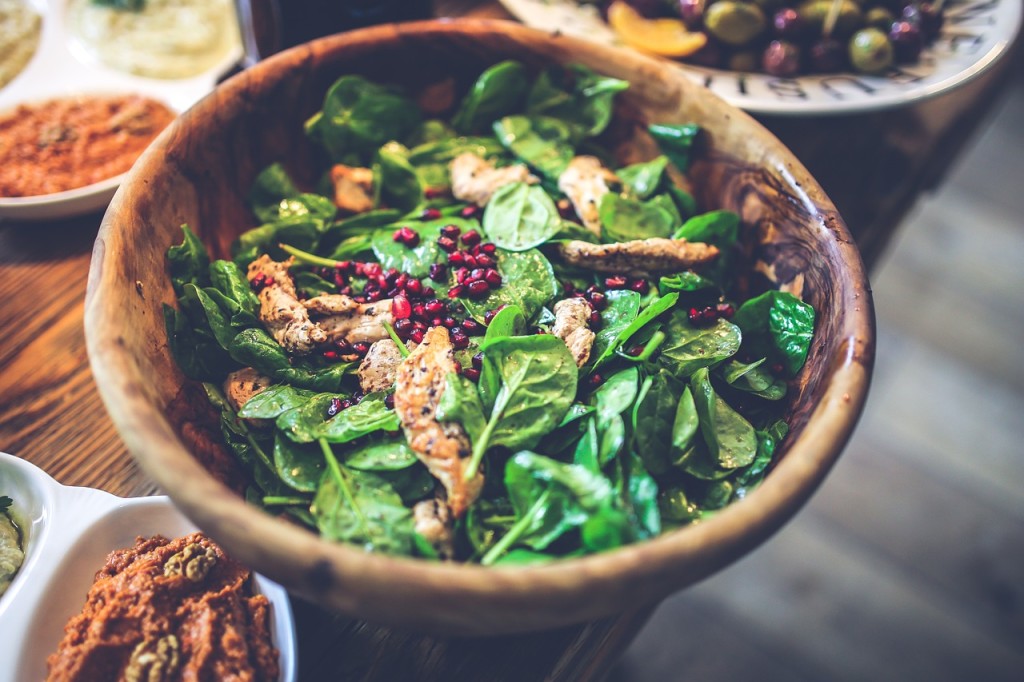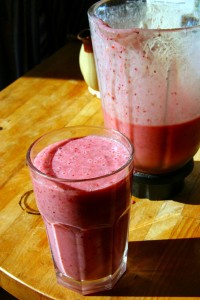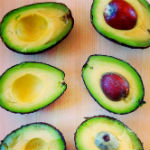
by Michelle Dwyer | Sep 3, 2015 | Blog, Health, Recipes, Vegetarian/vegan
I was inspired to write this post based on a recent article that claimed salads had no nutritional value and should be avoided. I won’t bother sharing the article, from a major daily publication, but I will say that if you are talking about iceberg lettuce drowned in highly processed dressings full of unhealthy fats, sugar and additives, then yes I would agree. However, maybe it is because I’m from California or maybe it’s because I think of salad SO differently, but I think a hearty salad is not only very nutritious but delicious as well! The key: choose quality ingredients and go for variety!
Here’s my easy “Build a Hearty Salad” formula:
-
Choose a protein
-
Choose some vegetables
-
Choose some greens
-
Add some healthy fats
-
Optional: add some beans
-
Optional: add some whole grains, starchy vegetables or fruit

Protein: 3 oz (size of a deck of cards)
- chicken
- turkey
- grass-fed beef
- fish or shellfish
- hard boiled egg
- cheese*
- edamame
- tofu
- tempeh
- beans or lentils*
Vegetables: Pick 2 or more (1+ cup total)
- asparagus
- broccoli
- cauliflower
- cucumber
- red bell pepper
- green beans
- tomatoes
- zucchini
- carrots
- artichoke hearts
- onions
- mushroom
Greens: 1-2 cups
- cabbage
- kale
- mixed greens
- spinach
- arugula
- fresh herbs like parsley, cilantro, dill or basil
Healthy fats: 1-2 T.
- Nuts and seeds: almonds, walnuts, sunflower seeds, pistachios, pumpkin seeds, peanuts, pine nuts, Brazil nuts, hemp seeds, chia seeds, flax seeds
- cheese*
- olive oil
- avocado
- olives
Beans & legumes: ½ cup (optional)
- beans: garbanzo, black, pinto, kidney, white or cannellini
- lentils
Whole Grains, Starchy Vegetables or Fruit: 1/3- 1/2 cup (optional)
- quinoa
- barley
- millet
- bulgur
- brown rice
- sweet potato or yams
- beets
- winter squash like roasted butternut or delicata
- pomegranate seeds
- berries like strawberries or blueberries
- fresh figs
- citrus like orange or grapefruit
- mango
*some foods could count in either category: for example, cheese could be a protein or a fat and beans/lentils could be the protein in the salad or added for more fiber!

A few other tips and suggestions for building your hearty salads:
- Choose organic whenever possible! See my previous post on Buying Organic for more information.
- Go for variety and start with ingredients you love. The beauty of this list is to mix and match with the nutritious foods you already enjoy eating. Be creative!
- Raw vegetables hard for you to digest? No problem. Lightly steam vegetables and then cool and store them for salads later. Or use leftover roasted vegetables from a previous meal. In fact, the entire “salad” can be thrown into a pan on medium heat and eaten as stir-fry if your body doesn’t do well on raw or it’s winter and your body wants warm food.
- Don’t skip the fat! You need healthy fats to help you absorb those wonderful fat-soluble vitamins like A, E, and K.
- Don’t have time to make a salad every day? Consider my favorite thing: Salad in a Jar (lots of great ideas on this post too!)
- Most pre-made dressings are full of sugar, processed oils, and additives. There are a few better options out there, but in general I suggest making your own dressings. (See below for a few ideas and suggestions.) If you are out or don’t have a lot of time, fresh lemon juice, olive oil and a little black pepper will always be delicious!
Easy Dressings
Balsamic Vinaigrette
- 3/4 cup extra-virgin olive oil
- 1/4 cup balsamic vinegar
- Sea salt
- Fresh-ground pepper
- Optional extras: spoonful of mustard, minced shallots, minced garlic, minced fresh herbs, teaspoon dried herbs, small spoonful of honey or maple syrup
“Creamy” Greek Dressing
- 1-2 tablespoons of olive oil
- 1 tablespoon Dijon or stone-ground mustard
- 2-3 tablespoons of tahini or hummus (to taste)
- 1-2 tablespoons of lemon or apple cider vinegar
- sea salt and pepper to taste
- optional: fresh or dried dill
- water to thin, if necessary
Asian-Style Dressing
- 1/4 cup orange juice
- 1 tablespoon of orange zest
- 1/4 cup rice vinegar
- 1 tablespoon toasted sesame oil
- 1 teaspoon fresh ginger, finely grated
- EITHER 2 tablespoons reduced-sodium tamari, reduced-sodium soy sauce, or Bragg’s amino acids OR 1 ½ tablespoons of white miso
Lemon-Mint Vinaigrette
- 1/3 cup lemon juice
- 1 tablespoon Dijon or stone-ground mustard
- 1 clove garlic, minced
- 1/3 cup extra-virgin olive oil
- 1/3 cup chopped fresh mint
- 1/8 teaspoon salt
- Freshly ground pepper, to taste
- Optional: dash of honey or maple syrup
What is your favorite thing to put into a salad? Do you have a go-to combination that works for you or do you like to mix it up?

by Michelle Dwyer | Jun 7, 2015 | Blog, Health, Recipes, Vegetarian/vegan
I love making smoothies and have one for breakfast just about every day. It’s a yummy, easy way to make sure I’m getting a good amount of protein to start the day plus some great nutrients. I’ve posted about protein powder before, but wanted to give everyone some more ideas for what to put in their smoothies. I’ve adapted my suggestions from the No Meat Athlete’s Perfect Smoothie Formula post.
Basic Ingredients:
- 1/2 cup frozen or fresh fruit
- 2-4 tablespoons protein powder
- 1-2 tablespoons binder
- 1/2 cup of greens or veggies
- 1 tablespoon oil
- 1/2 soft fruit
- sweetener (optional, less or more as needed)
- 8-10 ounces of liquid
- optional superfoods, greens, and other ingredients (see below)
- 3 ice cubes (omit if fruit is frozen or if you don’t want it too cold)
 Directions: Select one or more ingredients of each type below and add to blender in specified proportions. Blend until smooth.
Directions: Select one or more ingredients of each type below and add to blender in specified proportions. Blend until smooth.
VARIATIONS AND CHOICES FOR SMOOTHIE INGREDIENTS
Frozen or Fresh Fruits
- Strawberries
- Blueberries
- Blackberries
- Raspberries
- Peaches
- Mango
- Pineapple
Protein Powders
- Hemp (ground whole hemp or shelled hemp hearts)
- Pea protein powder
- Vega brand protein powders (sweetened with stevia)
- Sprouted brown rice
- Lifetime Life’s Basic’s Plant Protein
- Collagen hydrolysate (NOT vegetarian)
(Note: Soy and whey are higher-protein options, but for a variety of reasons I don’t recommend either for long-term use)
Binders
- Ground or soaked flaxseed
- Almond butter or any nut butter
- Soaked raw almonds (soak for several hours and rinse before using)
- Rolled oats, whole or ground (as tolerated)
Greens/Veggies
- Spinach
- Frozen kale (blends a bit better)
- Lettuce
- Zucchini
- Cucumber
Oils
- Flaxseed oil
- Udo’s Blend or other EFA blend
- Hemp oil
- Coconut oil
- Almond, macadamia, or other nut oil
Liquids (unsweetened)
- Water
- Almond milk or other nut/seed milk
- Hemp milk
- Brewed tea (green or herbal)
Soft Fruit
- Avocado
- Banana (avoid if keeping to a lower sugar eating plan)
- If you have a high-speed blender that can puree a whole fruit or vegetable without leaving any chunks behind, then almost any fruit or vegetable can act as your soft fruit
Sweeteners (optional or use sparingly)
Superfoods, Greens and Other Ingredients
- Cacao nibs or carob chips (1-2 tablespoons)
- Ground organic cinnamon (1-2 teaspoons)
- Chia seeds, whole or ground (1-2 tablespoons)
- Greens powder (1-2 teaspoons)
- Maca powder (1-2 teaspoons)
- Sea salt (pinch)
- Lemon or lime juice (1 tablespoon)
- Vanilla or almond extract (1-2 teaspoons)
There are so many possibilities and options with smoothies, so be creative and find the combination that works for you!

by Michelle Dwyer | Oct 23, 2014 | Blog, Health, Nutrition, Recipes, Vegetarian/vegan
Many people benefit from eating every 3 to 4 hours. A great way to be sure your body is getting the energy it needs is to eat a mid-morning and/or afternoon snack. Snacks are generally smaller and lighter than meals, but look for ones that are nutrient-rich. Nutrient-rich means that the food is concentrated in vitally important vitamins, minerals, antioxidants, phytonutrients, fiber, and energy.
Many of these items can be mixed and matched. For instance, add some almond butter to your apple or swap the tortilla for gluten free crackers for your avocado salsa. Adding enjoyment and variety to your snacks makes them more enjoyable for you and also adds different nutrients to your diet. Also, be sure to consider your own biochemical individuality—what works for YOUR dietary system and nourishes YOU—when choosing healthy snacks!
Nuts or seeds like almonds, walnuts, sunflower seeds or pumpkin seeds—raw & unsalted (1/4 cup = 1 serving)
Nutrition: Good source of protein & healthy fats; also good sources of fiber, calcium, magnesium, manganese, zinc, folate, vitamin E, & B vitamins; varies depending on nut/seed.
Tips: Remember that 1/4 cup is a serving size, so enjoy but do not over-‐indulge. Many people find nuts and seeds easier to eat and digest if they have been soaked or sprouted first.
Hummus or other healthy dip and veggies (carrots, celery, red bell pepper, broccoli, radish or pea pods)
Nutrition: Fiber, phytonutrients, & vitamin C. Carrots are also a great source of vitamin A, K, biotin and fiber. Celery is a good source of potassium, and vitamins B6 & B1.
Tips: These are easy to pack ahead of time and make for a yummy, crunchy snack. For some other healthy dip ideas, check out this artichoke dip or this olive pistachio dip or this vegan pesto!
Almond butter and whole-grain, seeded crackers like Mary’s Gone Crackers (2 T. almond butter & about 7-10 crackers)
Nutrition: For benefits of almond butter, see nuts/seeds above. Whole-grain crackers are higher in fiber & other minerals than crackers made with enriched flour.
Tips: Look for crackers without a lot of additives and ingredients; simple is best.
Whole grain or corn tortilla, avocado and salsa
Nutrition: Avocados are good sources of fiber, vitamin C, E, K, folate & potassium. Tomatoes are great sources of vitamin C, biotin vitamin K, carotene & lycopene.
Tips: Use about a ½ avocado in a serving. For the other half, leave the pit in the fruit and place in the refrigerator in a sealed container—it will keep for the next day.
Fruits like apples, oranges, berries, plums, or pears
Nutrition: Good amounts of antioxidants, fiber, phytonutrients, vitamin C; amounts vary depending on the fruit
Tips: It sounds so simple but fruits with a high fiber count can be quite filling and refreshing as a snack. Can pair with some almond butter for some added fat and protein.
Roasted seaweed
Nutrition: Good source of vitamins A and C and iodine.
Tips: This delicious snack is a great way to add sea vegetables to your diet. Great as an after-workout snack! The iodine in seaweed can help regulate hormones like estrogen and thyroid.
Roasted chickpeas
Nutrition: Excellent source of phytonutrients, molybdenum and manganese. They are also a very good source of folate and copper as well as a good source of dietary fiber, phosphorus, protein, iron, and zinc
Tips: Make these yourself because the ones in the store are usually full of added sugar. For an easy recipe, check out here or here.
Edamame
Nutrition: High in protein and low in fat; good source of fiber, thiamin, iron, magnesium, phosphorus and copper, vitamin K, folate & manganese.
Tips: You can get shelled edamame in the frozen food section of most stores. Add soy sauce, tamari or Bragg’s if you want some flavor. If you have thyroid issues or a food sensitivity to soy, you will want to avoid soy products.
Baked kale
Nutrition: Good source of vitamin A, vitamin C, calcium, and potassium.
Tips: Great for if you want something crunchy and savory with the benefits of kale. Easy to make yourself or can get at the store.









